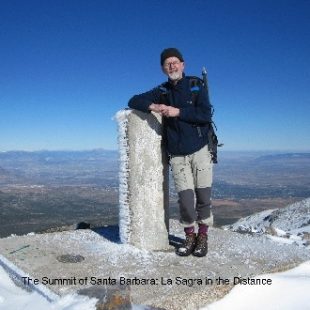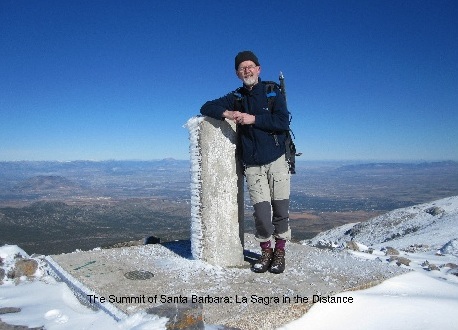
The lesser known peaks of Andalucia
In his book “Gatherings from Spain”, the 19th century traveller Richard Ford, referred to Spain as being “one big mountain”.
Despite the fact that Spain has an average altitude of 660 metres, with 24% being above 1000 metres and 76% between 500 and 100 metres, the knowledge that Spain is the second most mountainous country in Europe, comes as a surprise to many, who tend to presume that after Switzerland, it must be France.
With this knowledge onboard, it should come as less of a surprise that Andalucia, so vividly abundant in mountains and ranges, ranging from the serrated to the smooth, the gentle to the severe, could be described as being a “mountaineer’s paradise”.
And none more so rapturous and ‘crying out’ to be explored than the variegated mountains circling a vast stretch of plain lands known as the Hoya de Baza, where although the soil is poor from long and harsh summers, olive and almond trees proudly obtrude the vista, existing only by the patient nurture of the local farmers.
When 71-year-old Bill Douglas decided to escape the miserable British winter and embark on a trip to a rural inland area in the eastern corner of Andalucia, he did not know what to expect.
This sentiment of anticipation was reciprocated by the owners of the accommodation Mr Douglas had booked to stay in, whom, although their guest had told them he was a fit and ‘young’ 71-year-old, keen on mountaineering and cycling, had not prepared themselves for the sprightly chap who walked in, with a gusto and nimbleness normally lost in one of such years.
In compliance with his affirmations of physical fitness and spirited activity, Bill Douglas, with the help of his more than accommodating host, Chris Whitehead, spent much of the duration of his stay, climbing many of the “lesser known peaks of Andalucia”, making the most of, not only the sensational weather Andalucia was blessed with this winter, but also the scenery, so magnificent, that even a tourist of Chamonix in France or Wengen in Switzerland would be satisfied with.
Santa Barbara
At 2,268 metres high, Santa Barbara is the highest peak in the Sierra de Baza, and being surrounded by a panoramic maze of fragrant pine trees, veiling a host of flora and fauna, surrendering to some easy-angled slopes, Santa Barbara tenderly beckons one to her summit. Talking of his experience on Santa Barbara’s summit, Bill Douglas commented:
“From the summit the panorama of the surrounding sierras was stunning. To the south the Sierra Nevada lay under a thick duvet of snow glistening in the sun, while to the north La Sagra, reared up in isolation out of the surrounding terrain.”
La Sagra
Inspired by its lonely posture, three days later Bill and Chris reached the summit of Mount La Sagra, whose severed situation and slightly portentous name, allows climbers of La Sagra to justifiably conclude that accomplishing this peak may be more than a little challenging. Although its veneer is worse than its bite, and climbing Mount La Sangra, although a little rocky and steep in places, is neither difficult nor intimidating.
“An easy path through shallow snow led to the summit of la Sagra, from where there were once again spectacular views in all directions. If I thought our day on Santa Barbara could not be bettered our ascent of Santa Barbara proved me wrong. At the age of seventy-one you relish such days with a fervour which might appear exaggerated or pretentious at thirty.”
Rapa and San Sebastian
What could be a better activity to do to mark the feast day of San Sebastian than climb the peak of San Sebastian?
Another significant peak of the Sierra de Baza at 2227.5 metres tall, the steep and rocky summit of Rapa is reached through an open forest of pine trees.
“Under our feet low-growing myrtle-like bushes gave up to a sweet aromatic scent as we crushed them. It was not long before we were at the cylindrical stone pillar which marked the summit,” Bill commented.
Criss-crossing their way across a snowfield, Bill and Chris made their way to the summit of San Sebastian. Although, despite the atmosphere of solitude being in these Spanish sierras invokes, the ramblers were not alone on their quest to conquer the peak of San Sebastian, as the tracks of deer in the snow were detected.
The Picon de Gor
The Picon de Gor is even less visited and discovered than the summit of Santa Barbara, which is of advantage to any walker in the area, whose venture is often accompanied only by a flock of alpine choughs seen flying overhead. Accessed via the village of Gor, the Picon de Gor, also in the Sierra de Baza, affords a truly memorable climb.
“The view from the summit seemed even more extensive and spectacular than from any of the other seven thousand foot tops we had already visited. To the east-north-east snow-capped Santa Barbara glistened in the sun. The summits of San Sebastian and Rapa to the south-east reminded us of the great day we had climbing them,” Bill fondly mused.
Bill Douglas and Chris Whitehead are justifiably proud of their achievements this winter, in conquering the lesser known peaks of Andalucia, and in doing so, defying the snow, the sometimes treacherous terrain and not to mention age.



